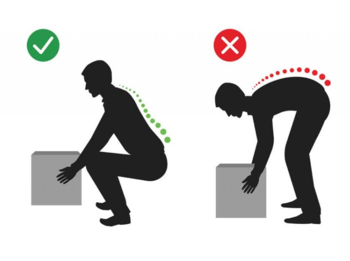Introduction
How to Prevent Spinal Injuries during Exercise: Exercise and sports are essential for maintaining a healthy lifestyle, promoting physical fitness, and enhancing overall well-being. However, participating in physical activities also carries the risk of spinal injuries, which can be both painful and debilitating. Preventing spinal injuries during exercise and sports is crucial to ensure safe and enjoyable physical activity. In this comprehensive blog, we will explore effective strategies to prevent spinal injuries, understand common risk factors, and adopt proper techniques to support a healthy spine while engaging in various activities. We can discuss more about How to Prevent Spinal Injuries during Exercise.

- Introduction
- Understanding Spinal Injuries in Exercise and Sports
- Preventive Strategies for Spinal Injury Prevention
- Spinal Injury Prevention for Specific Activities
- Proper Lifting Techniques
- Hydration and Nutrition
- Regular Stretching and Flexibility
- Listen to Your Body and Seek Medical Attention
- Conclusion
- Spine treatment In Gwalior.
Understanding Spinal Injuries in Exercise and Sports
The spine is a complex structure composed of vertebrae, discs, nerves, and muscles that work together to support the body and facilitate movement. During exercise and sports, the spine is subjected to various forces and movements that can lead to injury if not performed correctly. Common spinal injuries during exercise and sports include: We can discuss more about How to Prevent Spinal Injuries during Exercise.

a. Strains and Sprains: Overexertion or improper body mechanics can lead to strains (muscle injuries) or sprains (ligament injuries) in the back or neck.
b. Herniated Discs: Repetitive movements or sudden trauma can cause the gel-like center of a disc to protrude through its outer ring, resulting in a herniated disc that may compress nearby nerves.
c. Fractures: High-impact activities or falls can lead to vertebral fractures, which may require medical attention and rest for recovery.
d. Sciatica: Compression or irritation of the sciatic nerve can cause pain, tingling, or numbness radiating down the leg. We can discuss more about How to Prevent Spinal Injuries during Exercise.
Preventive Strategies for Spinal Injury Prevention
Preventing spinal injuries during exercise and sports requires a combination of preparation, proper technique, and awareness. Here are essential strategies to safeguard your spine:

a. Warm-up: Always warm up before engaging in physical activities to prepare your muscles and joints for the movements ahead.
b. Use Proper Technique: Learn and practice proper techniques for exercises and sports to minimize strain on the spine.
c. Gradual Progression: Progress gradually in intensity and difficulty levels to give your body time to adapt and reduce the risk of overuse injuries.
d. Cross-Train: Engage in a variety of exercises and sports to avoid repetitive strain on specific muscles and joints.
e. Rest and Recovery: Allow your body sufficient time to recover after intense workouts or competitions to prevent overuse injuries.
f. Listen to Your Body: Pay attention to any signs of discomfort or pain and modify or stop the activity if needed. Pushing through pain can exacerbate injuries.
Spinal Injury Prevention for Specific Activities
Different exercises and sports carry unique risks for spinal injuries. Understanding and implementing specific preventive measures can help safeguard your spine during various activities: We can discuss more about How to Prevent Spinal Injuries during Exercise.
a. Weightlifting and Strength Training:
Always maintain proper form and technique during weightlifting exercises.
Use appropriate weights for your fitness level and avoid lifting beyond your capacity.
Engage your core muscles to support your spine during lifting movements.
b. Running and Jogging:
Wear supportive footwear to absorb impact and reduce strain on your spine.
Avoid overstriding and maintain an upright posture while running.
c. Yoga and Pilates:

Focus on proper alignment during yoga poses to protect your spine.
Gradually progress in difficult poses and avoid forcing yourself into extreme positions.
Read More:
| Hip replacement surgery |
| Knee replacement surgery |
| Shoulder surgery |
| Foot and ankle surgery |
| Understanding the Anatomy of the Spine: An Overview |
| Tips for Maintaining a Healthy Spine at the Office |
d. Contact Sports (e.g., Football, Rugby):
Wear appropriate protective gear, such as helmets and pads, to reduce the risk of impact-related injuries.
Follow the rules and regulations of the sport to minimize the risk of collisions and dangerous plays.
e. Cycling:
Adjust your bike’s seat and handlebars to promote a neutral spine position.
Engage your core muscles to stabilize your spine while cycling.
Core Strengthening for Spinal Support
A strong core is vital for supporting the spine and reducing the risk of spinal injuries during exercise and sports. Incorporate these core-strengthening exercises into your routine: We can discuss more about How to Prevent Spinal Injuries during Exercise.
a. Plank: Engage your core muscles to maintain a straight line from head to heels while holding a plank position.
b. Dead Bug: Lie on your back, raise your arms and legs, and extend opposite arm and leg while maintaining a stable core.
c. Russian Twist: Sit with your knees bent and feet off the ground. Twist your torso to one side and then the other while holding a weight or medicine ball.
d. Superman: Lie on your stomach, extend your arms and legs, and lift them off the ground while engaging your core muscles.
Proper Lifting Techniques

Improper lifting techniques can lead to strains and injuries in the back. Follow these steps for safe lifting:
a. Bend your knees and hips, not your back, to squat down and grasp the object.
b. Keep the object close to your body while lifting.
c. Use your leg muscles to lift, not your back.
d. Avoid twisting while lifting; instead, pivot your feet to change direction.
Hydration and Nutrition
Staying hydrated and maintaining proper nutrition are essential for spinal health and injury prevention. Hydration supports the spinal discs’ ability to absorb shock, while a balanced diet provides essential nutrients for bone and muscle health.
Regular Stretching and Flexibility
Incorporate stretching exercises into your routine to improve flexibility and reduce muscle tension. Flexibility promotes a full range of motion, decreasing the risk of injury during physical activities.
Listen to Your Body and Seek Medical Attention
Paying attention to your body and understanding its limits is crucial for preventing spinal injuries. If you experience persistent pain, discomfort, or any signs of spinal injury, seek medical attention promptly. Early intervention can prevent further complications and facilitate a quicker recovery.
Conclusion
Preventing spinal injuries during exercise and sports is essential for maintaining an active and healthy lifestyle. By implementing the strategies discussed in this blog, such as proper technique, core strengthening, and gradual progression, you can reduce the risk of spinal injuries and enjoy your physical activities safely. Remember that listening to your body, using proper form, and seeking professional guidance when needed are key components of spinal injury prevention. Prioritize your spinal health, and it will support you in leading a fulfilling, active life for years to come.
Spine treatment In Gwalior.
Dr. Vipin Garg Klm Spine Clinic in Govindpuri, Gwalior has a well-equipped clinic with all the modern equipment. The clinic has separate waiting and consultation areas which allow enough space for patients to wait conveniently at the clinic.
We are best At Orthopaedic, Ophthalmology, X ray. Physiotherapy .
Book Your Consultation
Website: https://tinyurl.com/yyzvwmck
Email: info@klmgrou p.org
Ph: 0751-4000721,Mob: 7804826825
Address: 12, Saraswati Nagar, University Road, Near Silver Estate, Thatipur, Address Link: https://g.page/r/CQ0WqKLEXPWeEAE Powered By Argusdna

